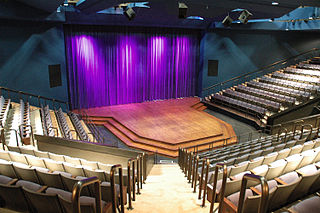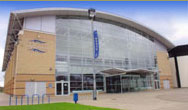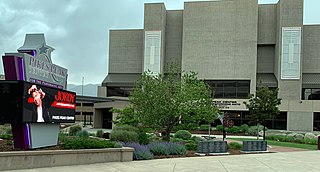
A proscenium is the metaphorical vertical plane of space in a theatre, usually surrounded on the top and sides by a physical proscenium arch and on the bottom by the stage floor itself, which serves as the frame into which the audience observes from a more or less unified angle the events taking place upon the stage during a theatrical performance. The concept of the fourth wall of the theatre stage space that faces the audience is essentially the same.

The Royal Shakespeare Theatre (RST) is a Grade II* listed 1,040+ seat thrust stage theatre owned by the Royal Shakespeare Company dedicated to the English playwright and poet William Shakespeare. It is located in the town of Stratford-upon-Avon – Shakespeare's birthplace – in the English Midlands, beside the River Avon. The building incorporates the smaller Swan Theatre. The Royal Shakespeare and Swan Theatres re-opened in November 2010 after undergoing a major renovation known as the Transformation Project.

In theatre, a thrust stage is one that extends into the audience on three sides and is connected to the backstage area by its upstage end. A thrust has the benefit of greater intimacy between performers and the audience than a proscenium, while retaining the utility of a backstage area. This is in contrast to a theatre in the round, which is exposed on all sides to the audience, is without a backstage, and relies entirely on entrances in the auditorium or from under the stage. Entrances onto a thrust are most readily made from backstage, although some theatres provide for performers to enter through the audience using vomitory entrances. As with an arena, the audience in a thrust stage theatre may view the stage from three or more sides. Because the audience can view the performance from a variety of perspectives, it is usual for the blocking, props and scenery to receive thorough consideration to ensure that no perspective is blocked from view. A high-backed chair, for instance, when placed stage right, could create a blind spot in the stage left action.

The Curtain Theatre was an Elizabethan playhouse located in Hewett Street, Shoreditch, just outside the City of London. It opened in 1577, and continued staging plays until 1624.

The Oregon Shakespeare Festival (OSF) is a regional repertory theatre in Ashland, Oregon, United States, founded in 1935 by Angus L. Bowmer. The Festival now offers matinee and evening performances of a wide range of classic and contemporary plays not limited to Shakespeare. During the Festival, between five and eleven plays are offered in daily rotation six days a week in its three theatres. It welcomed its millionth visitor in 1971, its 10-millionth in 2001, and its 20-millionth visitor in 2015.

An auditorium is a room built to enable an audience to hear and watch performances. For movie theatres, the number of auditoria is expressed as the number of screens. Auditoria can be found in entertainment venues, community halls, and theaters, and may be used for rehearsal, presentation, performing arts productions, or as a learning space.

In theatre and performing arts, the stage is a designated space for the performance of productions. The stage serves as a space for actors or performers and a focal point for the audience. As an architectural feature, the stage may consist of a platform or series of platforms. In some cases, these may be temporary or adjustable but in theaters and other buildings devoted to such productions, the stage is often a permanent feature.

A vomitorium is a passage situated below or behind a tier of seats in an amphitheatre or a stadium through which large crowds can exit rapidly at the end of an event. They can also be pathways for actors to enter and leave stage. The Latin word vomitorium, plural vomitoria, derives from the verb vomō, vomere, "to spew forth". In ancient Roman architecture, vomitoria were designed to provide rapid egress for large crowds at amphitheatres and stadia, as they do in modern sports stadia and large theatres.
Main stage or mainstage refers to the largest or most prestigious space of a theatre building and to the productions performed in that space. Mainstage theatre has been historically distinguished from smaller-scale studio theatre. It is usually performed in a proscenium theatre or on a thrust stage. Main stage is also used to describe the performance space with the largest audience capacity at a performing arts festival or other venues.

A theater, or playhouse, is a structure where theatrical works, performing arts, and musical concerts are presented. The theater building serves to define the performance and audience spaces. The facility usually is organized to provide support areas for performers, the technical crew and the audience members, as well as the stage where the performance takes place.

The Empire Theatre is a heritage-listed theatre at 56 & 56A Neil Street, Toowoomba, Toowoomba Region, Queensland, Australia. It was added to the Queensland Heritage Register on 31 May 1994.

Theater drapes and stage curtains are large pieces of cloth that are designed to mask backstage areas of a theater from spectators. They are designed for a variety of specific purposes, moving in different ways and constructed from various fabrics. Many are made from black or other darkly colored, light-absorbing material. Theater drapes represent a portion of any production's soft goods, a category comprising any non-wardrobe, cloth-based element of the stage or scenery. Theater curtains are often pocketed at the bottom to hold weighty chain or to accept pipes to remove their fullness and stretch them tight.

Grimsby Auditorium is a theatre situated on Cromwell Road, in Grimsby, North East Lincolnshire. With a seated audience capacity of 1,200 the Grimsby Auditorium is the largest professional theatre in Lincolnshire, and one of the larger theatres in the East of England. Built in 1995, it is today managed by Lincs Inspire on behalf of its owners North East Lincolnshire Council.

The Pikes Peak Center for the Performing Arts is a concert auditorium in Colorado Springs, Colorado. It serves as an entertainment, cultural, educational, and assembly center for the citizens of El Paso County, the Pikes Peak region, and the surrounding area.

The Maddermarket Theatre is a British theatre located in St. John's Alley in Norwich, Norfolk, England. It was founded in 1921 by Nugent Monck, and is situated next to Strangers' Hall.
There are different types of theatres, but they all have three major parts in common. Theatres are divided into two main sections, the house and the stage; there is also a backstage area in many theatres. The house is the seating area for guests watching a performance and the stage is where the actual performance is given. The backstage area is usually restricted to people who are producing or in the performance.

The Globe of the Great Southwest is a theater in Odessa, Texas inspired by the Globe Theatre. As well, the complex has a replica of Anne Hathaway's cottage. Both buildings are located on the campus of Odessa College.
The Boar's Head Theatre was an inn-yard theatre in the Whitechapel area of London from 1598 to around 1616.

The Tanghalang Pambansa, formerly Theater of Performing Arts, is a theater located in the Cultural Center of the Philippines Complex in Manila, Philippines.

The Allen Elizabethan Theatre has evolved since the founding of the Oregon Shakespeare Festival when the first performance of Twelfth Night was presented on July 2, 1935.


















